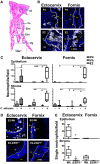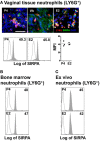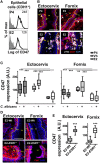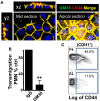Estrogen Receptor-Alpha (ESR1) Governs the Lower Female Reproductive Tract Vulnerability to Candida albicans
- PMID: 29881378
- PMCID: PMC5976782
- DOI: 10.3389/fimmu.2018.01033
Estrogen Receptor-Alpha (ESR1) Governs the Lower Female Reproductive Tract Vulnerability to Candida albicans
Abstract
Estradiol-based therapies predispose women to vaginal infections. Moreover, it has long been known that neutrophils are absent from the vaginal lumen during the ovulatory phase (high estradiol). However, the mechanisms that regulate neutrophil influx to the vagina remain unknown. We investigated the neutrophil transepithelial migration (TEM) into the vaginal lumen. We revealed that estradiol reduces the CD44 and CD47 epithelial expression in the vaginal ectocervix and fornix, which retain neutrophils at the apical epithelium through the estradiol receptor-alpha. In contrast, luteal progesterone increases epithelial expression of CD44 and CD47 to promote neutrophil migration into the vaginal lumen and Candida albicans destruction. Distinctive to vaginal mucosa, neutrophil infiltration is contingent to sex hormones to prevent sperm from neutrophil attack; although it may compromise immunity during ovulation. Thus, sex hormones orchestrate tolerance and immunity in the vaginal lumen by regulating neutrophil TEM.
Keywords: ESR1; cervix; estradiol; neutrophils; progesterone; transepithelial migration.
Figures











References
Publication types
MeSH terms
Substances
LinkOut - more resources
Full Text Sources
Other Literature Sources
Molecular Biology Databases
Research Materials
Miscellaneous

